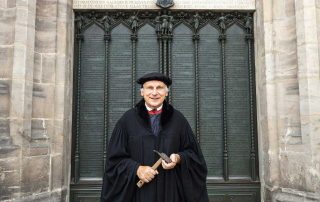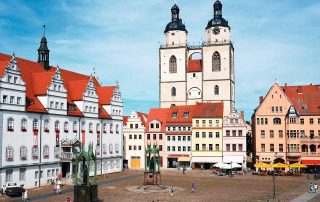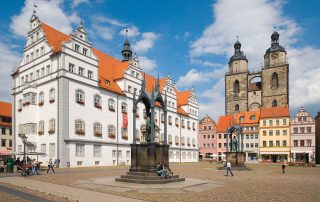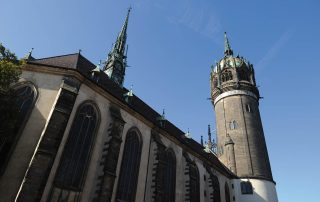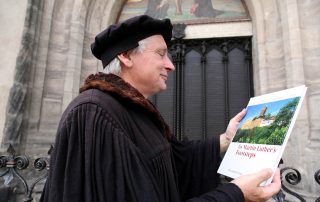
Luther memorials in Eisleben and Wittenberg
Even today, some 500 years after the Reformation and the beginning of the modern era, the atmosphere of those times can still be felt in Eisleben and Lutherstadt Wittenberg. This is where you’ll find unique Luther memorial sites such as the house where the Church reformer was born, the house where he died, the monastery where he lived and the church to which he nailed his 95 theses.
In 1996 these original sites of the Reformation were elevated to UNESCO World Heritage status on the grounds of their universal significance. Eisleben was where Martin Luther was born on 10 November 1483 and where he died on 18 February 1546 while travelling. There is plenty to see in the town’s old quarter: the historical market square, for example, with its splendid town houses. Then there’s the Luther statue and the historical town hall. Specific Luther sites include the house in which he was born, the church of St. Peter and St. Paul where he was baptised, St. Andrew’s Church with its original Luther pulpit, St. Anne’s Church with the only stone-carved biblical scenes in Europe and the Luther Museum in the house where he died.
The house of his birth, which the town turned into a memorial site as early as 1693, is Germany’s first ever museum and one of the oldest in the world. The house in which he died, a late-Gothic patrician town house dating from around 1500, has also been turned into a museum and memorial.
Luthers grave, however, is in Wittenberg. Here too, a stroll through the beautiful old town takes in memorials to Luther. These include the Castle Church, where in 1517 he nailed his 95 theses to the door, the burial sites of Luther and his friend and fellow protestor Philipp Melanchthon, the courtyards of the painter Cranach, the Town Church with its striking Cranach altar and the houses where Luther and Melanchthon used to live.
From 1511 and for the duration of his time in Wittenberg – including after he married in 1525 – Luther lived in the Augustineum, both as a monk and later a professor. The monastery was where he lectured to students from all over Europe and where he wrote the works that were to change the world. Luther’s House opened its doors to the public in 1883 and is now the largest museum of Reformation history anywhere in the world.
Luther Memorials in Eisleben an Wittenberg
UNESCO World Heritage since 1996
From the selection criteria
The Luther Memorials are of outstanding importance for the political, cultural and spiritual life of the western world, which extends far beyond the
borders of Germany.
Information and Contact
Tourist-Information Lutherstadt Eisleben und Stadt Mansfeld-Lutherstadt e.V.
Halleschestraße 4
06295 Lutherstadt Eisleben
Tel. +49 3475-60 21 24
Tourist-Information Lutherstadt Wittenberg
Schlossplatz 2
06886 Lutherstadt Wittenberg
Tel. +49 3491-49 86 10

